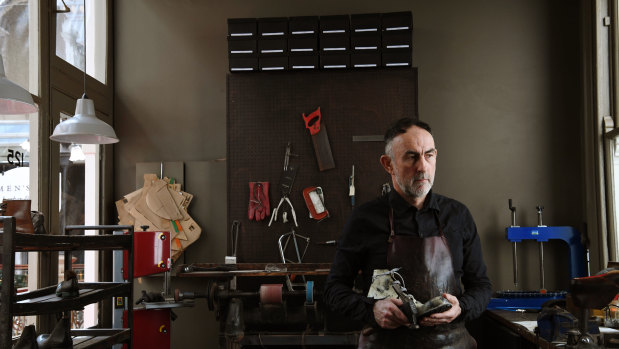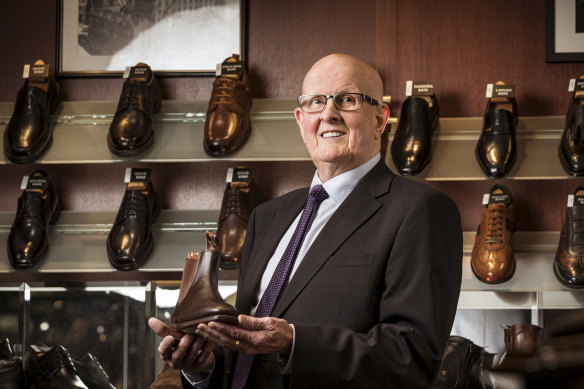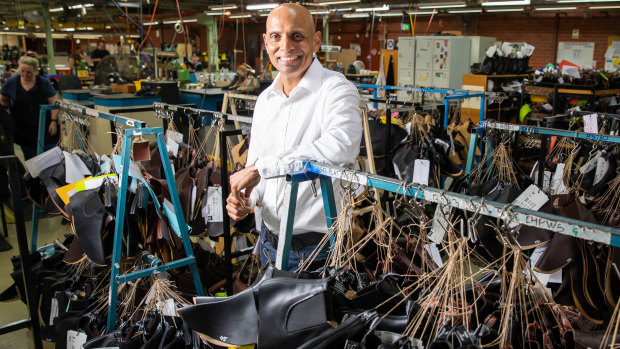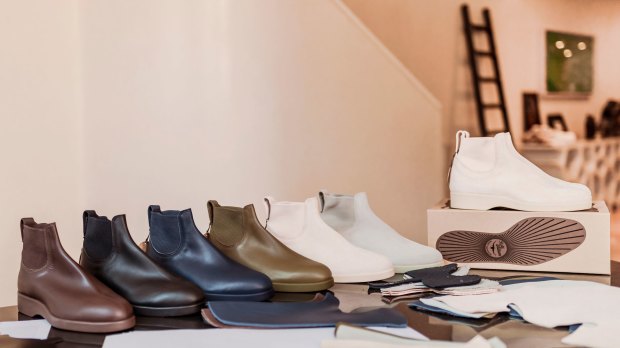This was published 5 years ago
Big boots to fill as private equity sizes up RM Williams
For Sydney shoemaker Andrew McDonald, there's a pretty simple pitch behind a pair of RM Williams boots.
"When you buy them it's no-frills," the experienced cordwainer says. "You just want quality."

Shoemaker Andrew McDonaldCredit: Louise Kennerley
That expectation of quality has been long baked into the iconic shoemaker's history, with founder Reginald Murray Williams saying his boots were for specialists, "people who expect them to last".
But now, as RM Williams' multinational owners size up a potential $500 million sale of the business to international private equity firms there are fears of a change in ethos at the company.
What you see is what you get
Williams himself first started making boots out of an Adelaide shed in 1932, and their unique no-lace construction saw them quickly become popular with farmers and stockmen.
Business boomed throughout the 20th century. In 1993 the company was acquired by a group of investors including News Corp executive Ken Cowley and media magnate Kerry Stokes.
In 2014 Cowley sold a majority stake the business to an arm of French luxury multinational Louis Vuitton, L Capital.
[RM Williams is] part of the heritage and fabric of the Australian way of life.
Former chairman Ken Cowley
L Capital was joined by local investment house IFM and 'greatest showman' Hugh Jackman, a 5 per cent shareholder and brand ambassador.
Under L Capital's ownership RM Williams has thrived financially. The company reported $23 million in earnings for the 2019 financial year, compared to a $152,000 loss in 2015 as a repositioning of the brand as a luxury product paid off.
But McDonald, a shoemaker for 30 years and long-time fan of RM Williams, says the 2013 ownership change was a turning point for the quality of the boots.
"At that time, the quality and composition of the shoes were still really great. What you saw was what you got," he says. "Since then we've seen this dilution of quality every time it gets sold.
"They've strayed from the heart and soul of their identity."

Second generation shoe maker and Mc Cloud Shoes owner, Peter Parkinson.Credit: Chris Hopkins
Second generation Melbourne-based shoemaker Peter Parkinson agrees there's been a change in the quality level of RM Williams boots in recent years, partially due to the scarcity of high-quality leathers.
"The difficulty in getting components and the fact the philosophy is still very much focused on Australian made has brought them into a category that's become difficult to maintain," he says.
"The boots today are still quite well made, they hang together okay, but you notice the materials don't hold up as nicely as they once did."
Neither shoemaker exclusively blames the company or its new owner for this perceived drop in quality, highlighting macro trends such higher labour costs. But but both agree the company has strayed from its quality-first, workwear roots.
RM Williams chief executive Raju Vuppalapati disputes this, telling The Age and The Sydney Morning Herald there's been no significant change in the boots' manufacturing process or materials in the years since its sale.
He says the company still use the same techniques the company employed 40 years ago, though the company has been investing in new "innovations" such as RM Williams recent burnished leather range.
"There's 80 hand-held processes in how we make the boot. Quality is the most important thing for any great brand," he says.
"While we respect we have to continue to be on point for the quality side of things, we need to be able to bring new innovation models to our craftsmen."

RM Williams CEO Raju Vuppalapati at the RM Williams plant in the northern Adelaide suburb of Salisbury.Credit: AFR
The company also sources its leather from a range of different locations, including from France for its higher-end boots and New Zealand for much of its Craftsmen range.
Hands on the leather
L Capital (now called L Catterton) enlisted Goldman Sachs to begin the sales process for RM Williams in May.
RM's strategy should be to get back to their roots, that's where they'll find their core customers.
Shoemaker Andrew McDonald
The company is expected to fetch $400 to $500 million, with a bevy of Asian luxury consumer brands, private equity firms, and local Australian firms reportedly being targeted.
Whoever picks the brand up will oversee an ambitious growth plan, with the company forecasting earnings to triple by 2024, fuelled by significant expansion into Asia, the UK and the US.
Vuppalapati's ideal buyer is someone who can see RM's potential for growth and recognises the company's Australian heritage.
"The buyer needs to recognise this is an Australian company, and they need to believe in the authenticity and provenance that underpins what this company is all about," he says.
The prospect of new international owners does little to allay Parkinson's concerns for the future of the business, believing RM Williams' future success hinges on the new owner's experience and philosophy.
"If they have some footwear expertise and are able to maintain and understand what's required, that's fine," he says. "But if they don't, it's headed for disaster."
A changing customer
Once synonymous with stockmen and farmers, you're now more likely to find a pair of RM Williams under the desks of Australia's big four banks and consulting firms.
This has been a conscious shift under LMVH's leadership, with Vuppalapati saying the company is targeting "boot boys and boot girls": younger Australians keen on longer-lasting fashion.

Marc Newson's yard boot design for RM Williams.
A collaboration with industrial designer Marc Newson formed part of this push, but a move into the trend-driven, designer fashion space is an "incredibly misguided" move, says McDonald.
Instead, he implores the brand to take inspiration from US success stories such as Chippewa and Red Wing and return to focusing on high-quality, durable workwear products.
"RM's strategy should be to get back to their roots, that's where they'll find their core customers."
"If you can get one guy at 16 to buy his first pair of RMs, and if you can get him to buy them for a lifetime, that's all you need."